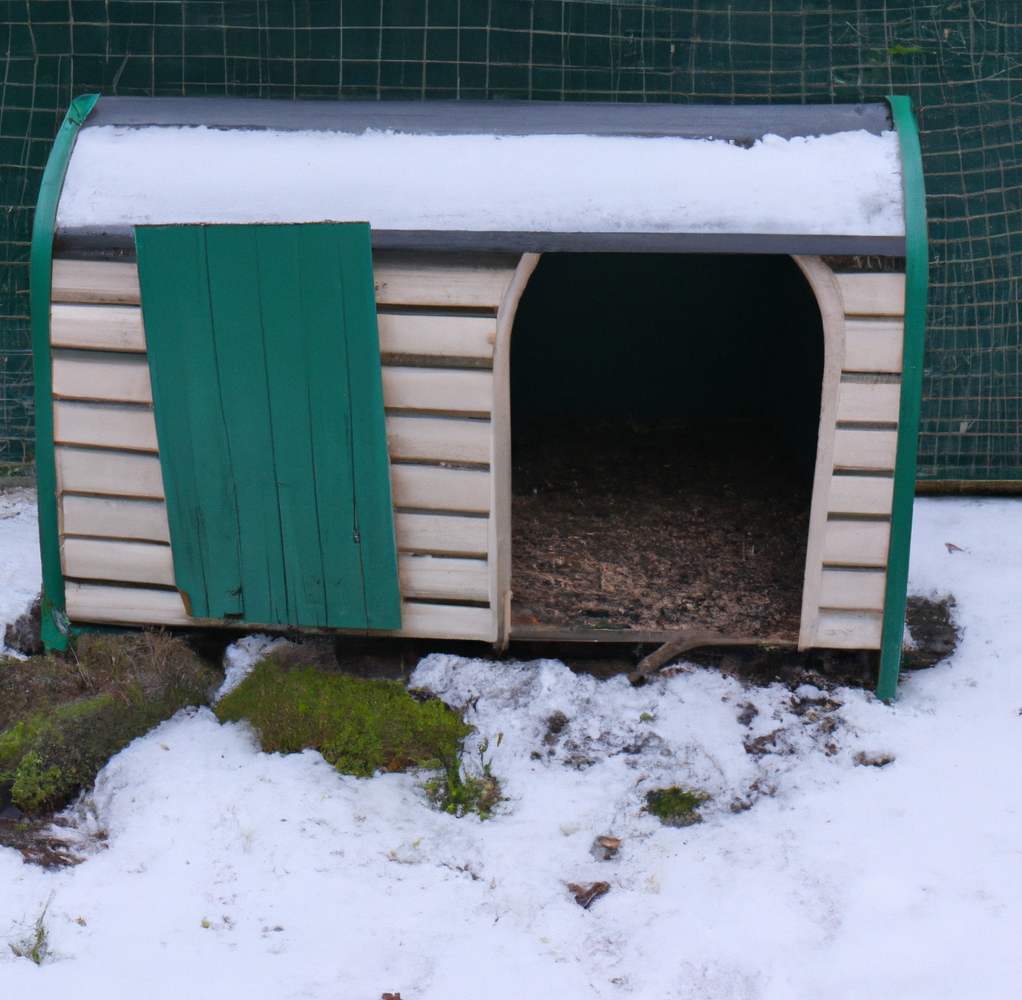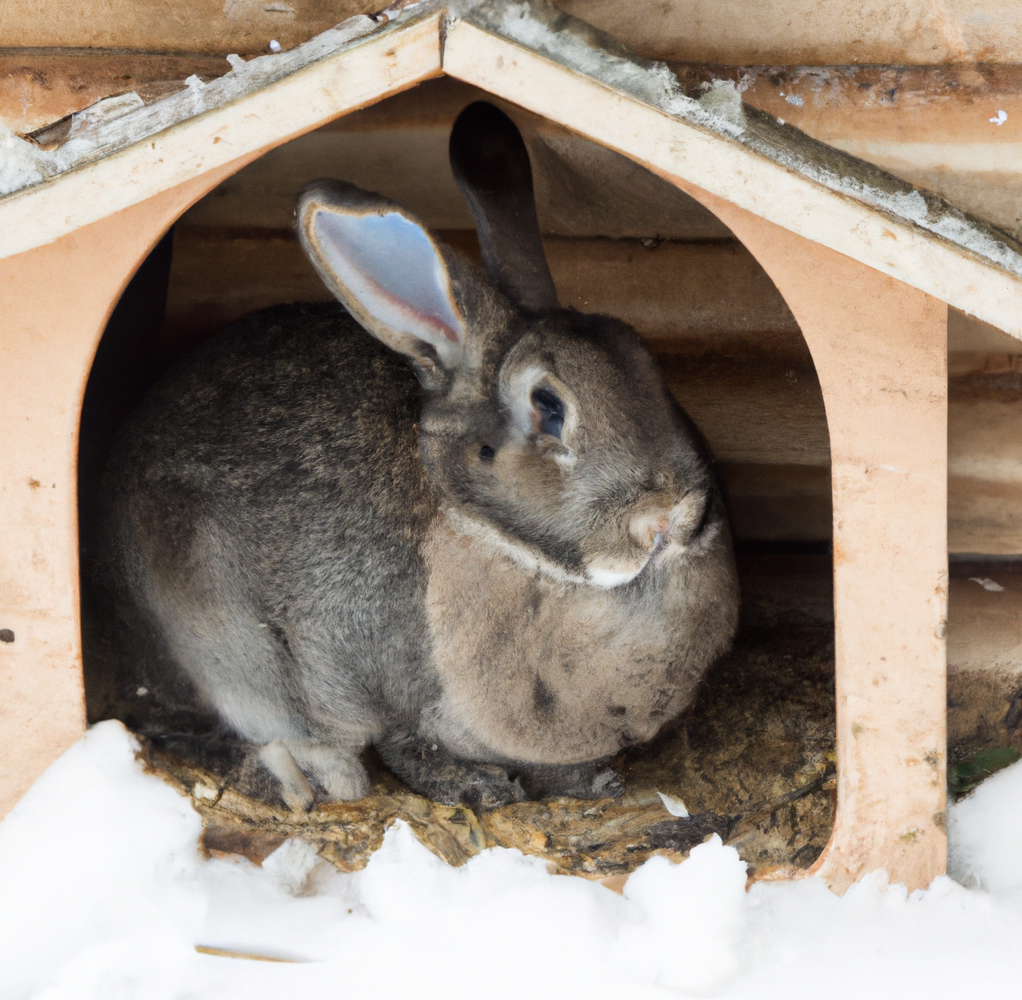Rabbits are commonly thought of as warm-weather animals, but they can actually survive in cold climates too. A rabbit’s thick fur and ability to burrow underground helps it stay warm in the winter. Understanding how rabbits stay warm in winter is important for those keeping them as pets, so they can ensure their rabbit’s comfort and safety. In this article, we’ll discuss some of the ways rabbits stay warm in winter and what you can do to make sure your pet stays safe and warm.
The Anatomy of a Rabbit: Exploring the Fur and Physiology That Keeps Rabbits Warm in Winter
Rabbits are small, furry mammals that are known for their speed and agility. They are also well adapted to surviving winter, thanks to their thick fur and specialized physiology. To better understand what makes rabbits so well-equipped for winter weather, let us take a closer look at the anatomy of a rabbit.
The rabbit’s thick fur is made up of two layers: the guard hairs and the undercoat. Guard hairs are long and coarse, and help to keep water and dirt away from the undercoat. The undercoat is much softer and thicker than the guard hairs, and helps to trap heat close to the rabbit’s body, keeping it warm.
The rabbit’s feet are also adapted for winter weather. Their feet are covered in fur, and their toes are spread out, allowing them to walk on snow without sinking in. The fur also helps to insulate them from the cold ground, and the pads of their feet are more resistant to the cold than human skin.
Rabbits’ ears are also adapted to keep them warm in winter. The outer ear is covered in fur and is slightly longer than the inner ear. This helps to keep the inner ear warm, as well as protect it from wind and moisture.
Rabbits also have a layer of fat beneath their skin to provide extra insulation. This layer of fat helps to keep the rabbit warm and regulate its body temperature in cold weather.
Finally, rabbits have an inner organ called a cecum which helps them digest cellulose. This is especially helpful in winter when food is scarce, as it allows them to get more nutrients from the plants they eat.
The combination of thick fur, spread-out toes, insulated ears, and an inner cecum allows rabbits to survive and thrive in cold climates. With these adaptations, rabbits are well-equipped to handle the winter months and live happily in the snow.
Tips for Winterizing Your Rabbit’s Cage and Environment
1. Move the cage away from cold drafts and out of direct sunlight. If your rabbit is living outdoors, bring its cage indoors or to a sheltered area.
2. Line the cage with extra bedding to provide insulation and warmth. Choose a bedding material that will not allow moisture to build up, such as straw, hay, or wood shavings.
3. Cover the cage with a blanket or sheet to further insulate it. Make sure the cover is securely fastened to the cage to prevent drafts.
4. Provide your rabbit with plenty of warm, clean water. Make sure to check the water at least once a day to ensure that it is not frozen.
5. Feed your rabbit high-fiber foods, such as hay and fresh vegetables. This will give your rabbit the energy it needs to stay warm during cold weather.
6. Offer your rabbit enrichment activities to keep it active and warm. Examples include digging boxes, foraging toys, and chew toys.
7. Monitor your rabbit’s behavior and make sure it is not showing signs of discomfort or distress. If you notice any changes, contact a veterinarian immediately.
How to Find (or Make) the Perfect Rabbit Winter Coat

Finding or making the perfect winter coat for your rabbit can be an important step in keeping your pet warm and cozy during the colder months. The following tips can help you find or make a winter coat that is both comfortable and functional for your rabbit.
1. Consider the Material: The most important factor when selecting a winter coat for your rabbit is the material. Look for a coat that is made from a soft, breathable material such as cotton, fleece, or wool. These materials are best for allowing your rabbit’s fur to breathe and keeping them warm and comfortable.
2. Choose the Right Fit: A winter coat should fit comfortably and snugly on your rabbit. If it is too tight or too loose, it will not be able to protect your rabbit from the cold effectively. Measure your rabbit’s neck, chest, and length before purchasing a coat.
3. Look for a Coat with a Hood: A hood can provide an extra layer of protection against the cold and wind. Look for a coat with an adjustable hood that can be tightened or loosened as needed.
4. Make Your Own: If you are feeling creative, you can make a winter coat for your rabbit. Look for patterns online or use an existing coat as a template. Sew the coat using a soft material such as cotton, fleece, or wool.
By following these tips, you can find or make the perfect winter coat for your rabbit. With the right fit and material, your rabbit will be warm and cozy all winter long.
The Benefits of Winter Burrows and Insulated Shelters for Rabbits
Winter burrows and insulated shelters can provide a variety of benefits for rabbits, from keeping them safe from predators to providing a comfortable habitat in colder climates. In this article, we will discuss the various advantages that rabbits can receive from winter burrows and insulated shelters.
Winter burrows, also known as warrens, are tunnels that rabbits dig underground during the colder months of the year. These burrows are designed to provide a warm and safe place for rabbits to escape the winter weather. The tunnels are usually dug at least two feet into the ground, with the entrance being well-insulated with grass, leaves, and other materials. This insulation helps keep the temperature inside the burrow warm, even when the outside environment is cold.
Insulated shelters, also known as hutches, are another popular choice for rabbit owners during the winter months. These shelters are constructed from wood, plastic, or other materials and are designed with insulation to help keep the inside temperature warm and comfortable for the rabbits. The insulation also helps to protect the rabbits from the elements, including wind, snow, and rain.
Both winter burrows and insulated shelters provide a variety of benefits for rabbits. For starters, both provide a warm and safe place for rabbits to hide from predators. Additionally, both burrows and shelters help to protect rabbits from extreme weather conditions. In extreme cold weather, burrows and shelters can help to keep rabbits warm by trapping their body heat. In hot weather, the insulation helps to keep the rabbits cool.
Furthermore, burrows and shelters can provide rabbits with a sense of security and privacy. Rabbits can retreat to their burrows or shelters when they feel threatened or overwhelmed. The insulation also helps to block out noise, providing an additional sense of privacy and security.
By providing a safe and comfortable environment, winter burrows and insulated shelters can help improve the health and well-being of rabbits. The warmth and insulation helps to keep rabbits healthy in cold winter weather, while the sense of security provided by burrows and shelters can reduce stress and anxiety. This can help to decrease the chances of rabbits developing illnesses or other health issues.
In conclusion, winter burrows and insulated shelters can provide many benefits for rabbits. By providing warmth, safety, and a sense of security, these burrows and shelters can help to keep rabbits healthy and happy during the colder months of the year.
The Importance of Proper Nutrition for Keeping Rabbits Warm in Winter
Rabbits are a popular choice of pet, due to their generally docile temperament and their soft and cuddly fur. However, like all animals, rabbits require proper nutrition in order to remain healthy and active. This is especially important during the winter months, when their fur and their bodies need the extra energy to keep them warm and protected from the cold weather.
A healthy rabbit diet consists of an appropriate balance of hay, fresh vegetables, and pellets. Hay should make up the majority of a rabbit’s diet, as it provides essential fiber and nutrients that rabbits need for their digestive health. Additionally, hay helps to keep a rabbit’s teeth worn down, which is important for dental health. Fresh vegetables, such as dark leafy greens, should also be included in a rabbit’s diet as they are full of vitamins and minerals. Pellets should be fed in small amounts, as they are often high in calories and can lead to obesity if given in excess.
In order for rabbits to stay warm during the winter months, it is important for them to have a diet that is high in calories. High-calorie foods, such as nuts, oats, and seeds, can provide the extra energy needed for rabbits to stay warm. Additionally, it is important to make sure that rabbits have access to plenty of fresh, clean water. Dehydration can lead to a decrease in energy, making it more difficult for rabbits to stay warm in cold temperatures.
Proper nutrition is essential for rabbits to remain healthy and warm during the winter months. A balanced diet of hay, fresh vegetables, pellets, and high-calorie snacks can provide the extra energy needed for rabbits to stay warm and active. Additionally, it is important to make sure that rabbits have access to plenty of fresh, clean water in order to stay hydrated. By following these simple guidelines, rabbits can stay healthy and warm in even the coldest of winter weather.
How to Provide Adequate Exercise for Rabbits During Cold Weather

During cold weather, it is important to provide adequate exercise for rabbits so they can stay healthy and active. Exercise helps rabbits stay physically and mentally fit, as well as aiding digestion and improving the overall health of rabbits.
The first step to providing adequate exercise for rabbits during cold weather is to provide a safe and secure outdoor space for them. This should be a large area with plenty of room for the rabbits to run around and explore. Make sure the area is protected from the elements and predators, and that it is large enough to accommodate the size of your rabbits.
The next step is to provide plenty of toys, tunnels, and obstacles for your rabbits to explore and play with. This will give them an opportunity to get physical exercise, as well as giving them mental stimulation. Try to provide items that can be easily rearranged and moved around so that the rabbits can stay interested and engaged.
Finally, it is important to provide your rabbits with ample opportunities to get outside and explore. They should be able to have supervised time outside of their enclosure. This will give them the chance to get some fresh air, explore new smells, and get some exercise at the same time. Make sure they are supervised at all times and that they are kept in a safe and secure area. If the weather is too cold, opt for an indoor play area instead.
By providing a safe and secure outdoor space, plenty of toys and obstacles, and ample opportunities to get outside, you can make sure your rabbits are getting the exercise they need during cold weather.
Conclusion
Rabbits are well-equipped to survive in cold weather with their thick fur coats, small size and well-insulated burrows. They also rely on their diet and the help of their huddle buddies to stay warm in the winter months. By following these tips and understanding the unique needs of rabbits in winter, owners can ensure their rabbits stay warm and safe all winter long.

